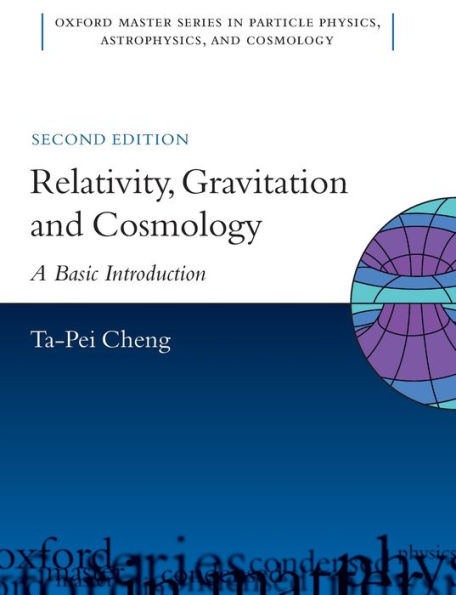Relativity, Gravitation and Cosmology: A Basic Introduction
Einstein's general theory of relativity is introduced in this advanced undergraduate and beginning graduate level textbook. Topics include special relativity, in the formalism of Minkowski's four-dimensional space-time, the principle of equivalence, Riemannian geometry and tensor analysis, Einstein field equation, as well as many modern cosmological subjects, from primordial inflation and cosmic microwave anisotropy to the dark energy that propels an accelerating universe.
The author presents the subject with an emphasis on physical examples and simple applications without the full tensor apparatus. The reader first learns how to describe curved spacetime. At this mathematically more accessible level, the reader can already study the many interesting phenomena such as gravitational lensing, precession of Mercury's perihelion, black holes, and cosmology. The full tensor formulation is presented later, when the Einstein equation is solved for a few symmetric cases. Many modern topics in cosmology are discussed in this book: from inflation, cosmic microwave anisotropy to the "dark energy" that propels an accelerating universe.
Mathematical accessibility, together with the various pedagogical devices (e.g., worked-out solutions of chapter-end problems), make it practical for interested readers to use the book to study general relativity and cosmology on their own.
1101391192
The author presents the subject with an emphasis on physical examples and simple applications without the full tensor apparatus. The reader first learns how to describe curved spacetime. At this mathematically more accessible level, the reader can already study the many interesting phenomena such as gravitational lensing, precession of Mercury's perihelion, black holes, and cosmology. The full tensor formulation is presented later, when the Einstein equation is solved for a few symmetric cases. Many modern topics in cosmology are discussed in this book: from inflation, cosmic microwave anisotropy to the "dark energy" that propels an accelerating universe.
Mathematical accessibility, together with the various pedagogical devices (e.g., worked-out solutions of chapter-end problems), make it practical for interested readers to use the book to study general relativity and cosmology on their own.
Relativity, Gravitation and Cosmology: A Basic Introduction
Einstein's general theory of relativity is introduced in this advanced undergraduate and beginning graduate level textbook. Topics include special relativity, in the formalism of Minkowski's four-dimensional space-time, the principle of equivalence, Riemannian geometry and tensor analysis, Einstein field equation, as well as many modern cosmological subjects, from primordial inflation and cosmic microwave anisotropy to the dark energy that propels an accelerating universe.
The author presents the subject with an emphasis on physical examples and simple applications without the full tensor apparatus. The reader first learns how to describe curved spacetime. At this mathematically more accessible level, the reader can already study the many interesting phenomena such as gravitational lensing, precession of Mercury's perihelion, black holes, and cosmology. The full tensor formulation is presented later, when the Einstein equation is solved for a few symmetric cases. Many modern topics in cosmology are discussed in this book: from inflation, cosmic microwave anisotropy to the "dark energy" that propels an accelerating universe.
Mathematical accessibility, together with the various pedagogical devices (e.g., worked-out solutions of chapter-end problems), make it practical for interested readers to use the book to study general relativity and cosmology on their own.
The author presents the subject with an emphasis on physical examples and simple applications without the full tensor apparatus. The reader first learns how to describe curved spacetime. At this mathematically more accessible level, the reader can already study the many interesting phenomena such as gravitational lensing, precession of Mercury's perihelion, black holes, and cosmology. The full tensor formulation is presented later, when the Einstein equation is solved for a few symmetric cases. Many modern topics in cosmology are discussed in this book: from inflation, cosmic microwave anisotropy to the "dark energy" that propels an accelerating universe.
Mathematical accessibility, together with the various pedagogical devices (e.g., worked-out solutions of chapter-end problems), make it practical for interested readers to use the book to study general relativity and cosmology on their own.
57.0
Out Of Stock
5
1

Relativity, Gravitation and Cosmology: A Basic Introduction
456
Relativity, Gravitation and Cosmology: A Basic Introduction
456
57.0
Out Of Stock

Product Details
| ISBN-13: | 9780199573646 |
|---|---|
| Publisher: | Oxford University Press |
| Publication date: | 01/11/2010 |
| Series: | Oxford Master Series in Physics , #11 |
| Edition description: | New Edition |
| Pages: | 456 |
| Product dimensions: | 7.40(w) x 9.60(h) x 0.90(d) |
About the Author
From the B&N Reads Blog
